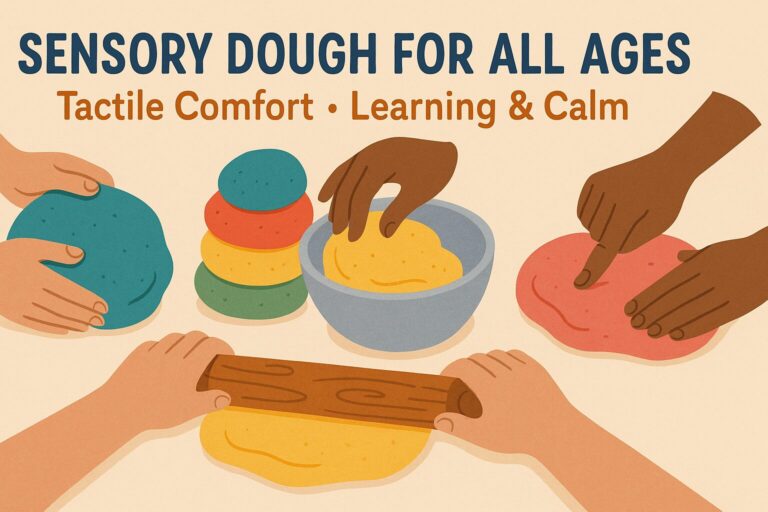Sensory dough—whether homemade or store-bought—is a therapeutic tool that offers tactile stimulation, creativity, and soothing deep touch feedback for everyone. From children developing fine-motor skills to adults managing stress or autistic individuals needing sensory regulation, this versatile dough delivers hands-on benefits.
🔍 Why Sensory Dough Works
- Fine motor development: Molding, squeezing, and shaping strengthens hand muscles and coordination.
- Calming tactile feedback: Soft resistance encourages focus, emotional regulation, and sensory grounding.
- Encourages creativity: Open-ended play stimulates imagination, especially when paired with tools or loose parts like loose sensory items or sensory sand.
- Olfactory enhancement: You can add soothing scents like lavender or vanilla for an aromatherapeutic touch.
- Supports all ages: Beneficial for kids, therapy clients, seniors, or anyone needing a tactile outlet.
✨ Easy DIY Sensory Dough Recipe
- Mix flour, salt, cream of tartar, water, oil, and food coloring—or add gentle scent like vanilla.
- Cook on low heat until it forms a soft dough, then knead until smooth and pliable.
- Store in an airtight container—plus optional inspiration: scented or glitter versions.
🧠 Activity Ideas with Sensory Dough
- Imprint exploration: Use textured objects like buttons, leaves, or cookie cutters for sensory stamping.
- Letter & shape practice: Roll or shape dough into letters—great for early literacy or cognitive tasks.
- Calming routines: Kneading dough while listening to calming music reinforces self-regulation tools like sensory projectors or weighted wraps.
- Community play: Adults and kids can co-create sculptures—sensory and social in one activity.
🙋♀️ Frequently Asked Questions
Is sensory dough safe for adults and seniors?
Yes—as long as it’s made with non-toxic ingredients. Seniors with arthritis or dexterity challenges may find it a helpful hand-strengthening tool.
Can I use scented oils or spices in the sensory dough?
Absolutely—natural scents like lavender, vanilla, or mint can deepen sensory engagement—but avoid allergens and use sparingly.
How long does homemade sensory dough last?
When stored properly, dough lasts 1–3 weeks. Cream of tartar helps improve texture and preservation.
As an Amazon Associate, SensoryGift.com earns from qualifying purchases. Thank you for supporting inclusive sensory resources for everyone.


